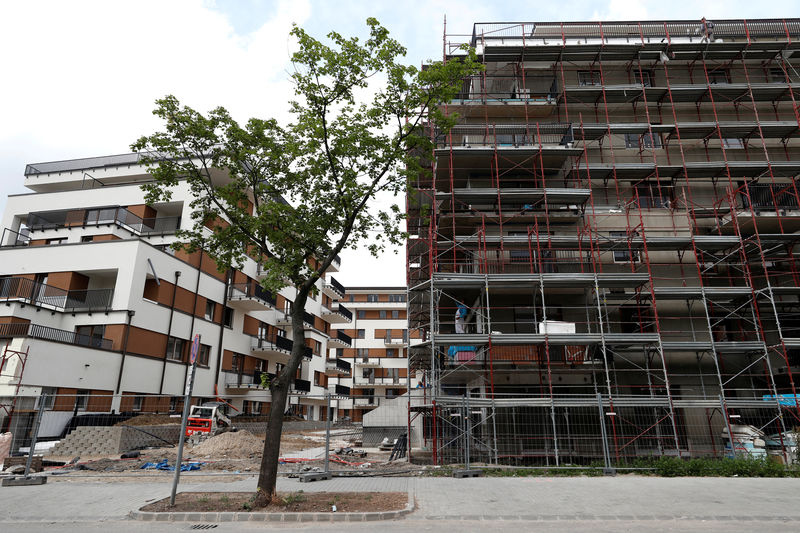 © Reuters. A block of new flats is built in Budapest
© Reuters. A block of new flats is built in BudapestBy Gergely Szakacs
BUDAPEST (Reuters) – After almost a decade in the doldrums, Hungary’s banks look set for years of lending growth that could help Prime Minister Viktor Orban’s efforts to keep the economy growing at a rate of 4 percent.
Banks’ growing loan books suggest they are finally emerging from years of tackling writedowns, the unloading of toxic assets and punitive government measures.
A Reuters survey of five major domestic banks showed all expect double-digit credit growth this year.
The turnaround will play into Orban’s hands as the premier, re-elected for a third term in April, embarks on a new stimulus program to lift economic growth to 4 percent per year in his new term, double the average since his return to power in 2010.
For the first time since Orban took office, the central bank’s financial conditions index, a measure of whether bank lending activity supports or hinders economic growth, inched into positive territory at the end of 2017.
That is a far cry from the malaise that ensued after Orban slapped banks with a hefty tax and various measures to help borrowers at the start of the decade, precipitating a plunge in lending that led a top banker to dub local lenders “zombies.”
Banks in Hungary say the current boom is driven by pent-up demand for loans, lower household debt levels than in richer European countries, and recent big wage hikes, all of which boost borrowers’ ability to service their debt.
“Mortgage lending has come a long way over the past years, and, recovering from a state of hibernation, we can now consider it a normally functioning market,” said Gabor Rajna, sales director at K&H Bank, Hungary’s second-largest lender by assets.
“We expect double-digit growth in the coming years, driven on the one hand by higher loan sizes due to rising real estate prices, as well as a growing number of transactions.”
Orban, who has expanded domestic ownership of the banking sector, is under pressure to boost growth as the latest Eurostat figures show Hungary lags most of its neighbors in terms of gross domestic product per capita, a gauge of living standards.
The Czech Republic and Slovakia lead eastern Europe in GDP per capita with 17,200 euros and 15,000 euros respectively, while Poland has caught up with Hungary at 11,800 euros based on 2017 data.
With banks firmly back in the black and demand for loans increasing due to a real estate boom and rising wages, the stage appears set for Hungary’s banks to turn the page on their past struggles.
“We expect a further expansion of the private sector credit stock on the forecast horizon, at an annual pace of about 4 to 7 percent through 2020,” the central bank told Reuters, adding that the corporate segment would outpace retail lending.
“This is largely in line with the projected evolution of nominal GDP, therefore, the credit-to-GDP gap is expected to close beyond the forecast horizon,” it said. The bank expects no overheating in lending in coming years.
STABLE FOOTING
The strengthening economy has also helped put lending on a more stable footing, as central bank data showed the proportion of distressed mortgages has plunged to 0.4 percent of loans issued since 2013.
OTP, central Europe’s largest independent lender, posted a 23-percent increase in first-quarter net profit, helped by a plunge in risk costs and stronger lending after a recent batch of acquisitions.
“We will do everything to boost our loan stock in Hungary to the biggest extent possible,” Deputy Chief Executive Laszlo Bencsik said. “Our activity is growing very dynamically.”
While demand in the Czech Republic is showing signs of a slowdown due to rising borrowing costs and tighter regulations, most banks in Hungary expect new mortgage issuance to rise by a double-digit margin this year.
The Czech Banking Association expects household lending growth, dominated by mortgages, to slow to 5.8 percent in 2018 and 5.5 percent in 2019 from 8 percent in 2017.
“The buoyant economy will spur a recovery in lending growth to about 10 percent in both 2018 and 2019,” credit rating agency Moody’s said. “Small and mid-sized companies and households will lead the demand for credit, but lending to large corporates will also pick up from weak levels.”
Mihaly Patai, the head of Hungary’s Banking Association, has said the sector could expect a return on equity of about 10 percent in the coming years, above a 7 percent EU-wide average, according to European Banking Authority data from 2017.
State-owned Budapest Bank sees a 30-40 percent increase in consumer and mortgage lending this year and said growth in these areas could exceed 15 percent in the next four to five years.
“A substantial amount of slack was amassed in retail lending in the past years,” the bank said.
Raiffeisen Bank sees a 25 to 35 percent rise in new retail loans this year, while CIB, the local unit of Intesa SanPaolo, projects 20 percent growth in the mortgage market this year. MKB Bank said last year’s “significant increase” in mortgage lending would continue in the coming years.
While the Czech and Romanian central banks have already started raising rates to combat price pressures, the National Bank of Hungary expects inflation to reach its target only by mid-2019, which allows it to keep interest rates at record lows. That also boosts cheap credit.
In addition, a rising number of fixed-rate loans is seen curbing risks from an expected normalization of European interest rates.
Source: Investing.com



























